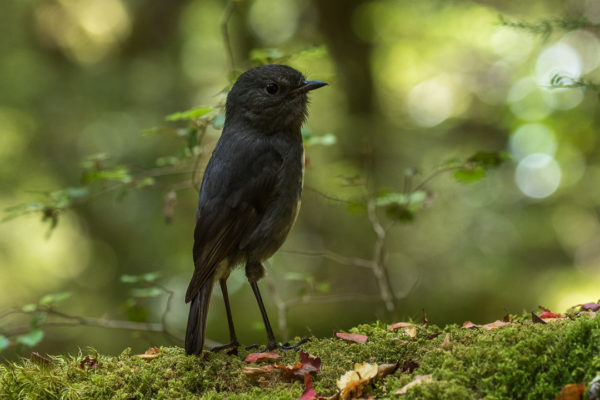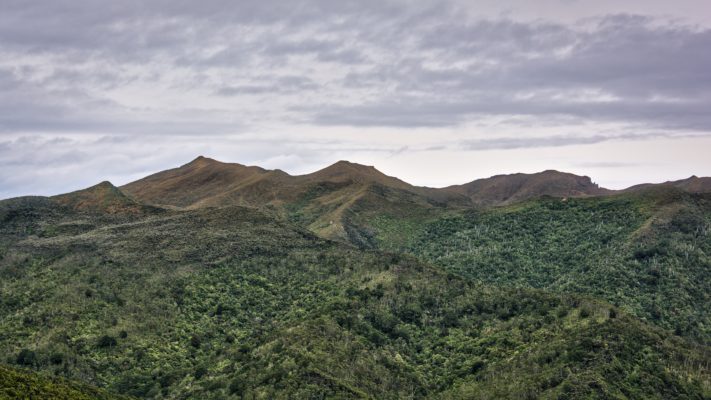When mammal predators first arrived in Aotearoa New Zealand, our native species didn’t know what had hit them and their naiveté led to some rapid extinctions. Have our surviving species ‘wised up’ to mammal threats in the last century or so?
Note: We are re-sharing our articles. This article was originally published on January 11, 2018.
If so, what happens when birds are moved to predator free islands or are protected behind a predator-proof fence? Do their descendants begin to lose the wisdom of their ancestors and become mammal-naive all over again?
It’s an interesting question and has important implications for any ecosanctuary-raised birds that decide to ‘fly the fence’ and explore the wider, predator-filled world. Otago Zoology student Aishwarya Muralidhar investigated these issues in a Masters thesis, available online through the University of Otago website.

“I described and compared adaptive anti-predator behaviours of South Island (SI) Robins (Petroica australis australis) residing within a mammalian predator-free region (Orokonui Ecosanctuary) with those inhabiting predator-dense regions (Silver Peaks and Silverstream).”
The research investigates differences in the intensity of anti-predator behavioural displays towards mammal predators (rats and stoats) between the regions, seasonal variation in those anti-predator displays, vocal responses to both native avian predators and introduced mammal predators and nest site selection in Orokonui compared with Silver Peaks/Silverstream.
“I discovered that SI robins in Orokonui had lost their predator recognition skills towards rat models and showed lower intensities of anti-predator displays than the SI robins at Silver Peaks and Silverstream. Orokonui’s robins may have retained behaviours towards stoat models due to a recent stoat incursion in the ecosanctuary. These results suggest that SI robins lose their anti-predator responses with the absence of specific predators in their habitat, and regain those behaviours upon encountering those predators again.”

Perhaps not surprisingly, the intensity of anti-predator behavioural displays in response to a perceived rat threat increased during the breeding season when robins had vulnerable chicks to defend.
“I discovered that SI robins showed less intense behaviours towards rat models during the non-breeding season than in the breeding season, though the decrease was significant with varying predation pressure. The absence of breeding mates, chicks, and altricial fledglings in the non breeding season possibly increased the costs of displaying anti-predator behaviour to avoid predation of self, and lowered the intensity of anti-predator display. No significant seasonal variation in responses towards the stoat model was observed, perhaps implying that the predation threat of stoats may be consistently high irrespective of the season.”
When it came to raising the alarm about predators, SI robins only gave vocal warnings about their traditional avian predators, moreporks and falcons and interestingly, may have had a different call to identify each.
“SI robins in this study gave alarm calls to avian predators but not to mammalian predators, and the alarm calls showed some acoustic differences that distinguished calls in response to moreporks from calls in response to New Zealand falcons at the species level. However, the functional reference of these alarm calls could not be conclusively determined.”
Could it be that the robins don’t have a ‘word’ yet for their new mammal enemies? They can call ‘morepork’ or ‘falcon’ but don’t have a vocal response for ‘rat’ or ‘stoat’. It’s an intriguing thought.
What about nest site selection? SI robins within Orokonui’s predator-proof fence could afford to be a bit more relaxed about finding a safe place to nest, but perhaps predation isn’t the only consideration when you’re setting up nest.
“Comparisons of protective habitat features between predator-free and predator-dense areas did not reveal statistically significant variations. Protective habitat features within regions reflected some adaptive selection of nest sites in response to both mammalian and avian predation, with SI robins preferring higher nests, greater nest concealment, and more ground cover in some predator-dense regions. A broader understanding of the complex interactions between habitat structure, predation pressure, and behavioural plasticity is required to confirm adaptive nest-site selection in SI robins.”
Overall, it seems that SI robins have adapted their behaviour in response to the presence of introduced mammalian predators, but become less cautious again in response to the removal of those mammal predators.
“The study provides evidence of behavioural loss in the absence of mammalian predators, and some verification of adaptive anti-predator behaviours in multipredator environments based on the predator’s hunting technique (mammalian versus avian tactics). Its ease of detection and susceptibility to predation makes the SI robin an ideal bird to assess the effectiveness of predator-control operations, and knowledge of its adaptive anti-predator behaviour could further help indicate the predation pressure in predator-managed areas.”
The full Masters thesis is available through the University of Otago’s “Our Archive” website.

